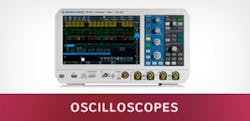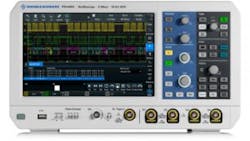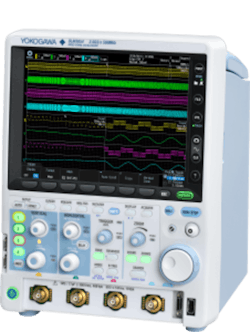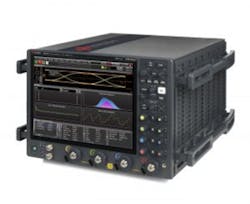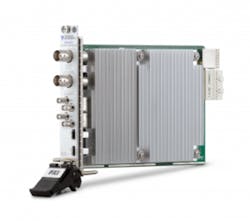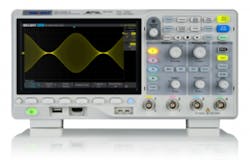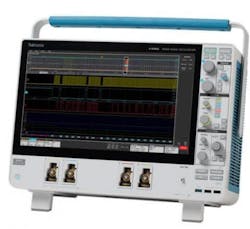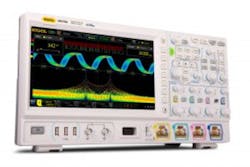2018 Special Report: Once high-end scope features now becoming mainstream
The oscilloscope has been test & measurement engineers’ bread-and-butter instrument for decades, with its roots dating back to the turn of the 20th century, and commercial versions available coming out of World War II. The tool has remained crucial ever since, undergoing constant evolution as the technology behind it has improved. Oscilloscopes are typically sorted into two categories—mainstream instruments that are well-suited for most applications, and high-end scopes that offer enhanced features for precise measurements and specialized applications. For the purposes of this report, we’ll focus on mainstream oscilloscopes.
In recent years, the mainstream scopes market has seen an influx of options and features—some traditionally reserved for high-end scopes—as price points have lowered over time. Oscilloscopes continue to become a better value even at the lower end of the price spectrum, showing that the test & measurement market is catering more to younger buyers who prefer flexibility in the buying experience. That experience now also includes a wide field of vendors to choose from, also helping the market’s competitiveness.
More and more mainstream oscilloscopes are gaining touchscreen user interfaces—a key improvement that is a draw to Millennial and Gen-X-aged engineers already well-versed in touchscreen products. Touchscreen displays speed up the instrument learning process and deliver a more interactive interface than traditional scopes.
The team at Rohde & Schwarz (R&S) has responded to these trends in earnest, having introduced multiple mainstream oscilloscopes over the last 14-20 months. The Munich, Germany-based T&M pioneer’s RTB2000-series, RTM3000-series, and RTA4000-series each share the same user interface (UI), same form factor (with high-resolution 10.1-inch touchscreen display), and same R&S-developed 10-bit analog-to-digital converter (ADC), starting at $1,370. The company has also introduced its newest high-bandwidth oscilloscope, the RTP, which goes up to 8 GHz today and features real-time de-embedding capability that enables it to de-embed a signal and maintain a fast update rate of 1M wfms/s and also trigger on the de-embedded signal.
“Over the last several years, there has been a big push for higher resolution and lower noise, especially as more attention has been paid to the amount of power that devices use, both during sleep and wake modes,” said Rich Markley, R&S oscilloscope product manager at R&S. “There has also been a desire to capture longer and longer periods of time. You can make up for a slower update rate by letting the scope run a few seconds longer, but you can’t make up for a lack of memory depth. Prior to our 2000/3000/4000-series of scopes, to get that really deep memory and higher resolution, you had to pay tens of thousands of dollars for an oscilloscope. Now you can get high resolution and deep memory starting
at $1,370.”
Elaborating on what features scope customers are now asking for, Markley emphasized signal resolution as a key driver due to a heightened focus on power and power consumption. “Looking at small signals in the presence of larger signals has always been tough and >8-bit oscilloscopes help with that,” Markley explained. “But it isn’t just about resolution—savvy users realize you need low-noise capabilities as well, or you just waste those extra bits digitizing the noise of the scope. And because many of these signals are now in the mV range, users are also looking for scopes that have full bandwidth and low noise at the smallest vertical/division settings.”
Markley went on to say that the ability to correlate time and frequency domain has become a bigger issue for customers, but that most implementations are slow and don’t act like a traditional spectrum analyzer. “We’ve focused on making those work together in an integrated fashion while keeping the oscilloscope very responsive,” Markley added.
Trending
We at Evaluation Engineering asked T&M vendors for their thoughts on current trends in oscilloscopes, what novel applications they are being applied to, and what vendors expect to see in 2019. Here’s what they had to say:
Richard Patterson, high-frequency instruments product manager at Yokogawa Corp. of America: “I believe usability is going to make engineers more productive. Even though oscilloscopes have gone digital long ago, we are only beginning to see the user experience change in the recent few years. Beyond that, real-time calculations eliminating the need for post-processing will help engineers finish their projects faster.
Trevor Smith, business development manager at Pico Technology: “We’re expecting that oscilloscopes will be widely deployed as “hardware in the loop” for complex system simulations that will deliver faster and more accurate analysis than in the past. Deep memory and high-speed connectivity will be crucial to address those applications.”
Brig Asay, director of strategic planning, Internet Infrastructure Group, at Keysight Technologies: “We now see scopes with excellent signal integrity above 100 GHz. We also see the continued pursuit of higher bits of resolution. Oscilloscopes finally have enough bandwidth to cover most major standards, so now, we as vendors are working to improve our signal quality.
“With the emergence of 5G, oscilloscopes are moving outside of digital and becoming a very good 2×2 or 4×4 MIMO receiver. Oscilloscopes have more bandwidth than a spectrum analyzer and have multiple channels, which makes them ideally suited for these types of wireless applications. We also see our oscilloscopes used in many long-haul communications applications. When coupled with the right O/E, they become a great Optical Modulation Analyzer. Recently, we have seen our scopes used in 802.11ay standards as well.”
Michael Rizzo, general manager at RIGOL USA: “The applications and use models are as wide and varied as the imagination of the engineers developing tomorrow’s technology. Continued price pressure and more advanced capabilities at lower price points are trends we anticipate continuing and which we feel we are well positioned to meet. Oscilloscopes are the hammer and wrench of the electronics industry.”
Jason Chonko, applications marketing manager at SIGLENT Technologies NA: “The next year or two will see an increase in the ease-of-use of many products. Large touchscreens, automatic measurement setup, and onboard web control will make it easier than ever to automate and monitor remotely as well as accomplish complicated tasks more efficiently.”
Wilson Lee, technical marketing manager at Tektronix: “There are three trends we see going into 2019: 1) More software, integrating with scope hardware to make difficult measurements and analysis easier; 2) More solutions, in the form of integrated instruments in one box as well as hardware bundles; 3) Continued emphasis on vertical resolution, ease of use, and upgradability. Bandwidth and sampling performance always rank high. Recently, vertical resolution has become more important, probably due to smaller signals and more sensitive circuitry. Ease of use is also important, especially for engineers whose scope usage goes in “spurts”. Probes are the subject of love and hate, especially as circuits shrink, becoming increasingly independent of earth ground, and become more sensitive to loading.”
Patrick Connally, technical marketing engineer at Teledyne: “The continued growth of deeply-embedded systems development means that requirements for instruments that combine high resolution, high bandwidth, long memory, and increased channel counts will also increase. Low-voltage power rails with increasing component sensitivity to power-rail abnormalities will require higher resolution and bandwidth and lower-noise oscilloscope acquisition systems to determine the root cause of power-rail abnormalities and system glitches.”
Now on the market
Oscilloscope vendors have responded to the trends mentioned above by offering new features and bringing price points down. Here’s a look at what mainstream scope products and solutions have been recently made commercially available in this space:
On Oct. 23, Yokogawa announced the new DLM3000 series of oscilloscopes. These models are two to four channels, with bandwidth options from 200 MHz, 350 MHz, or 500 MHz.
Yokogawa has redesigned the analog front end to cut residual noise in half (0.2 mVrms), and completely renewed the CPU platform to provide faster operations, faster data throughput, and touchscreen operation. The faster throughput is used to provide longer memory (up to 500 Megapoints) while still providing a fast update rate.
The DLM3000 series was designed with mechatronics applications in mind. This is most obvious in the long Time/Div and large memory Yokogawa makes available. If a machine has a startup sequence that lasts 100ms, that can be captured even while sampling all four channels at 2.5 GS/s. The new series boasts improved memory options going up to 500 Megapoints.
“However, true power is revealed when engineers use them to make on-board measurements,” Patterson said. “These instruments have 30 parametric measurements that can be calculated simultaneously. There are an optional four channels of real-time math for custom calculations. The power supply analysis option calculates harmonics, switching loss, I2t, and safe operating area. Yokogawa users will get more done inside the oscilloscope before needing to use external PC software.”
Patterson also highlighted the DLM3000’s history feature. During capture, data is automatically stored for up to 100,000 previous trigger events. This data is available for searching, overlaid views, individual or group saving to storage, and any of Yokogawa’s 30 parametric measurements can be performed on all historical data sets. Statistics are provided with a browsable, clickable list of all calculated results. For example, if 100,000 pulse widths are measured, the minimum pulse width can be found, and that data set immediately opened.
In September, Keysight announced the new Infiniium UXR-series of oscilloscopes, with models ranging from 13 to 110 GHz of true analog bandwidth. Key features include: 10-bit vertical resolution and signal integrity; sampling rates of 256 GSa/s per channel on 40 to 110 GHz models and 128 GSa/s per channel on 13 to 33 GHz models; up to four full-bandwidth channels with less than 35 fs (rms) of inter-channel intrinsic jitter; an optional full factory grade self-calibration module; a chipset based on a Keysight-proprietary indium phosphide process that enables wide bandwidth and low noise floor.
National Instruments recently introduced a new line of 8-bit, two-channel oscilloscopes—the PXIe-5110, 5111, and 5113. These models offer 100, 350, and 500 MHz of analog bandwidth respectively, include new glitch, width, and runt trigger capabilities, and are supported in NI’s InstrumentStudio software environment for interactive configurations and measurements. The PXIe-5110 specifically is now the company’s oscilloscope portfolio’s lowest cost option. NI recently introduced CableSense
technology to certain NI PXI oscilloscope models by incorporating a pulse generator behind the oscilloscope channels.
“Especially for long-running tests, nothing is more frustrating than having to throw data away and start over; CableSense technology will help mitigate this risk by catching setup changes early and qualifying the integrity of the measurements that follow,” explained NI’s PXI modular instruments product marketing manager Michael Keane.
“The PXI form factor allows several instrument types to fit in a compact, 4U physical space, and our new InstrumentStudio software environment houses the soft front panels for NI oscilloscopes, waveform generators, DMMs, SMUs, and power supplies in an integrated, multi-instrument panel,” he continued. “Hosting multiple instruments in an integrated panel provides combined screenshots and measurement results, along with project-level configuration files that save the settings for all instruments together. InstrumentStudio operates at the NI driver level on shared instrument sessions, which also allows engineers to monitor their automation or debug in tandem with running code using the same PXI hardware.”
In June of 2018, Pico Technologies launched its PicoScope 5000D series of flexible resolution oscilloscopes and mixed-signal oscilloscopes (MSO). PicoScope 5000D oscilloscopes feature up to 16 bits of vertical resolution with up to 200 MHz bandwidth and 1 GS/s sampling speed, while PicoScope 5000D MSO models add 16 digital channels, providing the ability to accurately time-correlate analog and digital channels.
PicoScopes are “PC based” instruments that take advantage of rapidly advancing PC processing power and display capabilities. The 5000D series PicoScopes feature a SuperSpeed USB 3.0 connection. The product is small and light, can easily be transported in a laptop bag, and operates silently thanks to its low-power fanless design. The products run with PicoScope 6 PC software that is regularly updated and offered free-of-charge to customers, as new capabilities and functionality is developed. PicoScopes come with a software development kit (SDK) that enables users to write their own applications. Smith said the company has seen PicoScope used in applications ranging from multinational high-energy physics experiments through to measurement of golf club shaft flex on the pro tour.
“PicoScopes are “Six-in-One” instruments: Oscilloscope, logic analyzer (on MSO models) spectrum analyzer, serial bus analyzer, function generator, and arbitrary waveform generator,” Smith said. “There are obvious cost and space savings having those capabilities in a single compact instrument, but there are technical benefits as well, with the capability to correlate measurements from one domain to another.”
In the last 20 months, SIGLENT has released the X-E series of entry-level scopes and a new flagship in the SDS5000X platform. The X-E scopes are low cost, but not low on features. They offer measurement resolution of 500 uV/div low range and free serial
decoding. Meanwhile, the SDS5000X is a workhorse with a touchscreen and features not found on scopes in its class, according to Chonko. “SIGLENT scopes are all about value,” Chonko said. “We feel that our products deliver the features that are essential for engineers to do their jobs quickly and under budget. This includes adding serial decoding to many of our scopes for free. We offer oscilloscopes with logic analysis, deep memory FFT math functions for frequency domain measurements, and integrated function generators. The biggest advantage is the space savings. An all-in-one approach can be helpful if there isn’t a lot of room available for test equipment.”
SIGLENT development engineers just added a free binary data translation tool to the company’s 4 channel X-E scope. This helps keep data rates high and makes it easy to convert the binary data to CSV for offline analysis.
Chonko said two of the more interesting scope applications he’s worked on are two science museum installations. One was using a scope to display the output voltage from an electric eel, and the other was displaying the sound waves emitted from an electric guitar.
Tektronix’ two newest offerings in mainstream oscilloscopes are the 5-series MSO that was introduced in June of 2017, and the 6-series MSO that launched in July of 2018. Both scopes are designed for upgradability in the field, and enabled by IP token. “Our scopes are designed to future-proof a customer’s evolving design work, and ultimately save time, and money,” Lee said. Those scopes feature large displays with “from the ground, up” pinch-swipe-zoom interfaces. FlexChannel inputs allow each channel to be used as either an analog input or eight digital inputs, while the scopes’ 12-bit vertical resolution has the ability to go up to 16-bit using oversampling in high-resolution mode. Both scopes include function generators, logic analysis, protocol support, and DVMs.
Lee said Tektronix’ 5-series MSO has been used extensively by a customer working on power electronic systems—from wireless charging stations to higher-power electric vehicle
systems.
Tektronix also offers two series of oscilloscopes that offer built-in spectrum analyzers—the MDO4000C series and the MDO3000 series. Lee said the MDO4000C is especially suited for EMC troubleshooting since it has the ability to show spectrum information, RF amplitude, and time domain waveforms (v vs t) in a synchronized view.
At RIGOL, the company recently introduced its Phoenix Chipset and Ultravision II Architecture. The first oscilloscope it introduced with the new chipset is the DS7000 series,
which offers performance from 100-500MHz with 10GSa/sec sampling. “We expand that capability for more cost-conscious embedded customers, educators, and enthusiasts with the new MSO5000 Series providing 8GSa/sec sampling between 70MHz and 350MHz,” Rizzo said. “Our customers look for value in their test and measurement solutions.
Price/Performance is a key but they are unwilling to compromise on quality, reliability, ease of use, or the advanced measurement and analysis capabilities required. RIGOL oscilloscopes deliver uncompromised technical solutions at transformational price points, fundamentally shifting the customer value proposition in this crowded market.”
Rizzo added that RIGOL’s Phoenix Chipset allows its new oscilloscopes to integrate seven instruments in one: Oscilloscope, logic analysis, protocol analysis, spectrum analysis, waveform generation, digital voltmeter, and counter/totalizer. Beyond those core functions, the UltraVision II scopes include advanced analysis capabilities like zone triggering, histogram analysis, advanced search, power analysis, record mode (segmented memory), and pass/fail analysis.
Teledyne LeCroy’s most recently introduced mainstream scopes are the WavePro HD and the WaveSurfer 3000z. The WavePro HD combines 12-bit vertical resolution, 8-GHz bandwidth, and up to 5 Gpts of acquisition memory in one instrument. “This is an unprecedented combination of high resolution and high bandwidth, as well as the largest amount of acquisition memory available in any oscilloscope,” Connally said. The WaveSurfer 3000z offers bandwidths from 100 MHz to 1 GHz, and available power analysis software package and active probe interface address power-electronics/conversion applications.
“Greater vertical resolution improves any/all measurements,” Connally said. “The WavePro HD’s combination of 8-GHz bandwidth and 12-bit resolution lends itself to power-integrity applications, EMC/EMI measurements, and high-speed serial debug. All of our oscilloscopes provide enormous flexibility in terms of triggering options; as well as built-in tools for capture, view, measure, math, analysis, and documentation. We also offer a broad lineup of serial trigger/decode packages.
Connally went on to cite how power integrity is becoming an increasingly important aspect of modern deeply-embedded computing system design and validation, and that customers are using Teledyne instruments to perform sophisticated power-integrity measurements on on-die power rails inside the chips, where vertical resolution is still critical, but the effects under study also require high bandwidth for accurate characterization.
Market outlook
A report released in October from Market Research Future1 stated that the global oscilloscope market is expected to grow from $2.3 billion in 2017 to $3.62 billion by 2023—a 5-year CAGR of 8.2%. The report cites a rising demand for automotive safety features as a major factor driving the market, along with the overall expected growth of consumer electronics. The report also cites limited screen display as one of the main challenges the scopes market is facing, but as evidenced above, vendors in this space appear to be making headway.
A previous report from Grand View Research2 noted the growing market for handheld oscilloscopes, which suggests scopes’ increasing use outside of the lab. Also noted is a move from fixed-function T&M unites to more modular, software-defined instrumentation that enables a standard testing device to alter its functions by running software. “Some higher priced equipment currently offers software options, but right now, the software-defined approach to T&M equipment is mostly aspirational, and at the high end of the market,” Grand View states. “It will be a while until general-purpose oscilloscopes offer a modular software option.”
That report goes on to note unit sales of T&M equipment in North America continue to accelerate and are consistent with reports of U.S. reshoring off consumer products, including smartphones. “Increase in demand for signal storage and self-monitored facilities, expected growth in general purpose test market, increasing intelligence of electronic devices, increasing bandwidth, user interface improvements, and modular instrumentation are expected to drive the market,” Grand View’s report said. “Competition, economic uncertainty and future-proof solutions are expected to be market restraints. Connectivity and convergence, social, smart as new green are the new trends in the market.”
References
1. Market Research Future, “Oscilloscope Market Research Report- Forecast to 2023”
2. Grand View Research, “Oscilloscope Market Analysis, Market Size, Application Analysis, Regional Outlook, Competitive Strategies And Forecasts, 2014 To 2020”
For more information
About the Author

